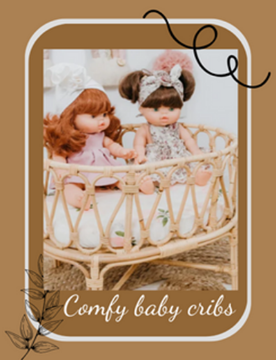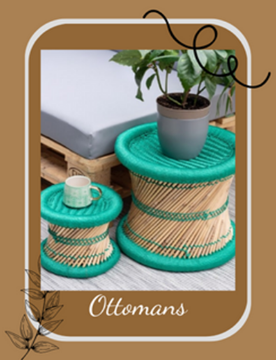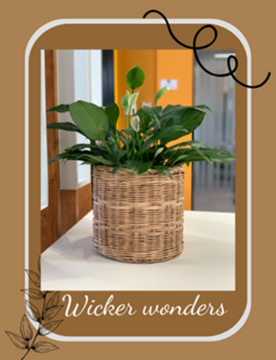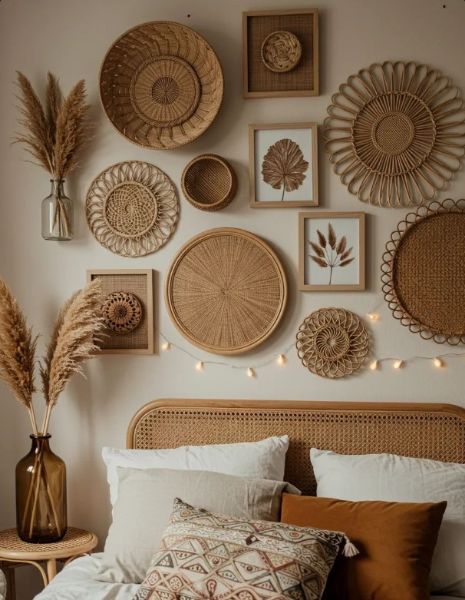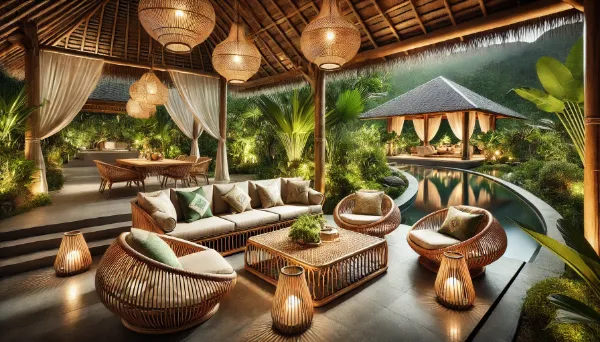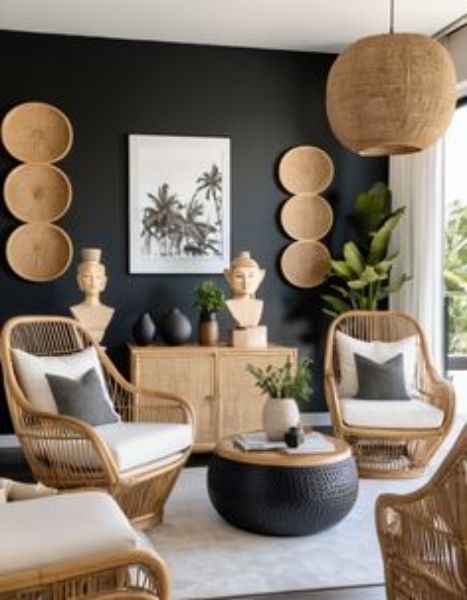The world of interior design is witnessing a remarkable shift toward sustainable living, and at the forefront of this movement stands jute rope furniture – a perfect marriage of environmental consciousness and timeless elegance. As homeowners across the globe seek alternatives to mass-produced synthetic furnishings, jute rope furniture emerges as a beacon of hope, offering durability, versatility, and undeniable aesthetic appeal that transcends cultural boundaries and design preferences.
Imagine walking into a space where every piece tells a story of craftsmanship, sustainability, and natural beauty. Jute rope furniture doesn't just fill your home with functional pieces; it creates an atmosphere of warmth, authenticity, and connection to nature that synthetic materials simply cannot replicate. From the bustling apartments of Tokyo to the countryside homes of Tuscany, from modern lofts in New York to traditional houses in Mumbai, jute rope furniture has found its place in hearts and homes worldwide.
This comprehensive guide will take you on a journey through the fascinating world of jute rope furniture, exploring its rich history, diverse applications, and the countless ways it can transform your living space into a sanctuary of style and sustainability. Whether you're a seasoned interior designer looking for fresh inspiration or a homeowner taking your first steps into eco-conscious living, this article will provide you with everything you need to know about incorporating these remarkable pieces into your décor.
Understanding Jute: The Golden Fiber Revolution
Jute, often called the "golden fiber," has been humanity's companion for thousands of years. This remarkable plant fiber, primarily cultivated in the fertile deltas of Bangladesh and India, represents one of nature's most versatile and sustainable resources. The jute plant (Corchorus capsularis and Corchorus olitorius) thrives in tropical climates with high humidity, making it an ideal crop for regions where other materials might struggle to grow.
The transformation of jute from plant to rope involves a fascinating process that has remained largely unchanged for centuries. After harvesting, the jute stems undergo retting – a natural decomposition process that separates the valuable bast fibers from the woody stem. These fibers are then stripped, washed, and spun into strong, durable ropes that form the foundation of beautiful furniture pieces.
What makes jute particularly special in the context of furniture making is its unique combination of strength and flexibility. Unlike synthetic materials that can feel rigid or artificial, jute rope maintains a natural suppleness that becomes more comfortable with use. The fiber's inherent properties include excellent tensile strength, natural antibacterial qualities, and remarkable durability when properly maintained.
From an environmental perspective, jute stands as a champion of sustainability. The plant grows rapidly, requiring minimal pesticides or fertilizers, and actually improves soil quality through nitrogen fixation. Its cultivation supports millions of farmers across South Asia, creating a positive economic impact that extends far beyond furniture production. When jute rope furniture reaches the end of its lifecycle, it biodegrades completely, leaving no environmental footprint – a stark contrast to synthetic alternatives that can persist in landfills for centuries.
The Art and Craft of Jute Rope Furniture Making
The creation of jute rope furniture represents a beautiful fusion of traditional craftsmanship and contemporary design sensibilities. Master craftsmen who specialize in this art form often come from generations of rope workers, carrying forward techniques that have been refined over decades. The process begins with selecting the finest quality jute rope, graded for consistency in thickness, color, and tensile strength.
Traditional weaving techniques form the backbone of jute rope furniture construction. The most common methods include:
Macramé Weaving: This ancient art form involves creating intricate patterns through knotting techniques. When applied to furniture, macramé creates stunning visual textures while maintaining structural integrity. The repetitive knotting process requires patience and skill, with each knot contributing to the overall strength and beauty of the piece.
Spiral Wrapping: This technique involves wrapping jute rope around a frame in continuous spirals, creating smooth, flowing lines that are both visually appealing and incredibly durable. The tension must be carefully controlled to ensure even distribution and proper support.
Cross-Hatching: By weaving rope in perpendicular patterns, craftsmen create surfaces that can support significant weight while maintaining flexibility. This technique is particularly popular for chair seats and table tops.
Braided Construction: Multiple strands of jute rope are braided together to create thicker, more substantial elements for furniture legs, arms, or decorative features. This method combines strength with visual interest.
Modern furniture makers have embraced these traditional techniques while incorporating contemporary tools and methods. Computer-aided design helps optimize rope placement for maximum strength and aesthetic appeal, while precision cutting tools ensure consistent rope lengths. However, the heart of the process remains deeply human – the skilled hands of artisans who understand how to coax beauty and functionality from natural fibers.
The frames used in jute rope furniture deserve special attention. High-quality pieces typically feature frames made from sustainable hardwoods, powder-coated steel, or aluminum. The choice of frame material significantly impacts the furniture's durability, weight, and overall aesthetic. Wooden frames offer warmth and natural beauty but require more maintenance, while metal frames provide excellent durability with minimal upkeep.
Comprehensive Types of Jute Rope Furniture and Products
The versatility of jute rope as a furniture material has led to an incredible diversity of products, each designed to meet specific functional and aesthetic needs. Understanding the full range of available options helps homeowners make informed decisions about incorporating these pieces into their living spaces.
Seating Solutions
Jute Rope Chairs: The most popular category includes dining chairs, accent chairs, lounge chairs, and bar stools. Modern jute rope chairs often feature ergonomic designs that provide excellent support while maintaining the natural flexibility that makes jute so comfortable. Dining chairs with jute rope seats and backs offer a perfect balance of formality and casual comfort, suitable for both everyday meals and special occasions.
Sofas and Sectionals: Larger seating pieces incorporate jute rope in various ways – from complete rope construction to hybrid designs that combine rope with traditional upholstery. Three-seater sofas with jute rope backs and arms provide excellent ventilation in warm climates while maintaining structural integrity for daily use.
Ottomans and Poufs: These versatile pieces serve dual purposes as seating and storage. Jute rope ottomans can be easily moved around spaces, providing flexible seating options for gatherings or quiet relaxation.
Tables and Surfaces
Coffee Tables: Jute rope coffee tables range from simple, minimalist designs with rope-wrapped legs to elaborate pieces featuring intricate weaving patterns on the tabletop itself. These pieces often become conversation starters, drawing attention to their unique construction and natural beauty.
Dining Tables: Larger dining tables incorporate jute rope as both structural and decorative elements. Some designs feature rope-wrapped pedestals, while others use rope as the primary support structure beneath glass or wood tops.
Side Tables and Consoles: Smaller accent tables provide opportunities to introduce jute rope furniture without overwhelming a space. These pieces work particularly well in entryways, bedrooms, or as plant stands.
Storage and Organization
Baskets and Containers: Jute rope baskets represent some of the most practical applications of this material. Available in countless sizes and shapes, these storage solutions work equally well for laundry, toys, magazines, or decorative displays.
Shelving Units: Rope shelving combines metal or wooden frames with jute rope panels, creating storage solutions that are both functional and visually interesting. These units work particularly well in bathrooms, bedrooms, or home offices.
Wardrobes and Armoires: Larger storage pieces might incorporate jute rope panels as door inserts, providing ventilation while maintaining privacy. These designs are particularly popular in tropical climates where air circulation is essential.
Outdoor and Patio Furniture
Weather-Resistant Collections: Specially treated jute rope furniture designed for outdoor use undergoes additional processing to resist moisture and UV damage. These pieces maintain the natural beauty of jute while standing up to the elements.
Hanging Chairs and Swings: Perhaps some of the most beloved jute rope furniture pieces, hanging chairs create perfect relaxation spots for patios, gardens, or covered porches. The natural flexibility of jute makes these pieces incredibly comfortable for extended lounging.
Planters and Garden Accessories: Jute rope planters provide excellent drainage while adding natural texture to garden spaces. These pieces work particularly well for herbs, succulents, or trailing plants.
Design Styles and Aesthetic Applications
The beauty of jute rope furniture lies in its remarkable adaptability to various design styles and cultural aesthetics. This versatility has contributed significantly to its global appeal, as designers and homeowners find ways to incorporate these pieces into virtually any décor theme.
Bohemian and Eclectic Styles
Jute rope furniture finds its most natural home in bohemian and eclectic design schemes. The organic textures and earthy tones complement layered textiles, vintage accessories, and collected treasures from around the world. In these settings, jute rope pieces often serve as grounding elements that tie together diverse decorative elements through their natural, unpretentious presence.
Bohemian spaces benefit from jute rope's inherent imperfections – the slight variations in color and texture that machine-made furniture lacks. These characteristics add authenticity and soul to spaces that celebrate creativity and individuality. Macramé wall hangings, rope-wrapped mirrors, and intricately knotted plant hangers work together to create cohesive bohemian environments.
Scandinavian Minimalism
The clean lines and natural materials favored in Scandinavian design make jute rope furniture an excellent choice for Nordic-inspired spaces. The neutral tones of natural jute complement the white, gray, and light wood palettes typical of Scandinavian interiors. Simple, geometric rope patterns align with the minimalist aesthetic while adding necessary warmth and texture.
In Scandinavian applications, jute rope furniture often appears in its most refined forms – clean-lined chairs with subtle rope details, simple storage baskets, or understated lighting fixtures. The focus remains on functionality and quality rather than ornate decoration.
Industrial and Urban Loft Aesthetics
The combination of jute rope with metal frames creates furniture perfectly suited to industrial design themes. Raw steel paired with natural rope creates compelling contrasts that embody the industrial aesthetic's celebration of materials in their honest forms. These pieces work particularly well in urban lofts, converted warehouses, and modern apartments with exposed brick or concrete elements.
Industrial jute rope furniture often features bold, structural designs that celebrate the engineering aspects of construction. Visible joints, exposed hardware, and geometric forms characterize these pieces, while the rope elements provide necessary softening and warmth.
Mediterranean and Coastal Themes
The natural, weathered appearance of jute rope makes it an ideal choice for coastal and Mediterranean design schemes. The material's association with maritime traditions – from ship rigging to dock hardware – creates authentic connections to seaside living. Salt-weathered appearances and sun-bleached tones that develop naturally over time enhance rather than detract from the furniture's appeal.
In coastal settings, jute rope furniture often appears alongside other natural materials like driftwood, sea glass, and shells. The combination creates cohesive environments that celebrate the beauty of natural elements shaped by time and weather.
Contemporary and Modern Applications
Modern designers have embraced jute rope furniture as a way to introduce natural elements into otherwise sleek, contemporary spaces. The contrast between high-tech materials and organic fibers creates dynamic tension that defines much of contemporary design. Clean-lined rope furniture with geometric patterns fits seamlessly into modern environments while providing essential textural interest.
Contemporary applications often focus on jute rope's sculptural qualities, creating furniture pieces that function as functional art. These designs might feature bold geometric patterns, unexpected color combinations, or innovative construction techniques that push the boundaries of traditional rope work.
Global Cultural Significance and Regional Variations
The global appeal of jute rope furniture extends far beyond simple aesthetic preferences, touching on deep cultural connections to natural materials, traditional craftsmanship, and sustainable living practices. Different regions of the world have developed unique approaches to jute rope furniture that reflect local customs, climatic needs, and design traditions.
South Asian Heritage
In Bangladesh and India, where jute cultivation originated, rope furniture represents a continuation of ancient traditions. Local craftsmen have developed sophisticated techniques passed down through generations, creating pieces that serve specific cultural needs. Traditional Indian rope beds (charpoys) demonstrate the practical wisdom of using rope construction in hot, humid climates where ventilation is essential for comfort.
Contemporary South Asian designers are revitalizing these traditional forms, creating modern interpretations that honor historical techniques while meeting current lifestyle needs. These pieces often feature intricate knotwork patterns that reflect regional artistic traditions, creating furniture that serves as cultural ambassadors.
Southeast Asian Adaptations
Countries like Thailand, Vietnam, and Indonesia have embraced jute rope furniture as a natural extension of their existing bamboo and rattan furniture traditions. The humid tropical climates of these regions make rope furniture particularly practical, as the natural ventilation properties help maintain comfort in challenging weather conditions.
Southeast Asian rope furniture often incorporates hybrid designs that combine jute with local materials like bamboo or teak. These combinations create unique aesthetic signatures while maximizing the practical benefits of each material.
European Interpretations
European designers have approached jute rope furniture with characteristic attention to detail and quality. Scandinavian countries, in particular, have embraced rope furniture as part of their broader commitment to sustainable design and natural materials. The clean, functional aesthetic of Nordic design pairs beautifully with the honest simplicity of rope construction.
Mediterranean countries have incorporated jute rope furniture into their outdoor living traditions, creating pieces that can withstand coastal conditions while maintaining comfort and style. The natural aging process of jute rope complements the weathered, lived-in aesthetic prized in Mediterranean design.
North American Innovation
In the United States and Canada, designers have pushed the boundaries of traditional rope furniture construction, incorporating modern materials and manufacturing techniques. American makers often combine jute rope with contemporary frames made from recycled metals or sustainable hardwoods, creating hybrid pieces that appeal to environmentally conscious consumers.
The outdoor furniture market in North America has particularly embraced jute rope construction, with manufacturers developing weather-resistant treatments that extend the life of rope furniture in challenging climates.
African Influences
African designers have found natural connections between jute rope furniture and traditional basket-making and textile traditions. The continent's rich history of working with natural fibers provides a cultural foundation for embracing rope furniture as both practical and aesthetically meaningful.
Contemporary African furniture makers often incorporate traditional patterns and motifs into rope furniture designs, creating pieces that celebrate cultural heritage while meeting modern functional needs.
Maintenance, Care, and Longevity Strategies
Proper maintenance is crucial for maximizing the lifespan and appearance of jute rope furniture. While these pieces are inherently durable, understanding the specific needs of natural fiber furniture ensures years of beautiful, functional service. The key to successful maintenance lies in understanding jute's natural properties and working with rather than against them.
Daily and Weekly Care Routines
Regular maintenance begins with simple daily habits that protect your jute rope furniture from unnecessary wear and damage. Positioning pieces away from direct sunlight prevents premature fading and fiber degradation. While jute can handle some sun exposure, prolonged direct sunlight will eventually cause colors to fade and fibers to become brittle.
Weekly dusting with a soft brush or vacuum cleaner attachment removes accumulated dust and debris that can work into the rope fibers. Pay particular attention to crevices and joints where dust tends to accumulate. A clean, dry paintbrush works excellently for reaching into detailed rope work where vacuum attachments might be too large.
For pieces used frequently, such as dining chairs or coffee tables, weekly inspection helps identify potential issues before they become serious problems. Look for loose knots, fraying rope ends, or signs of excessive wear in high-contact areas.
Deep Cleaning Techniques
Monthly or quarterly deep cleaning maintains the appearance and hygiene of jute rope furniture. The cleaning method depends on the specific construction and finish of each piece, but general principles apply across most jute rope furniture.
For light cleaning, mix a small amount of mild detergent with warm water. Using a clean cloth, gently wipe down rope surfaces, working in the direction of the rope twist. Avoid soaking the rope, as excessive moisture can lead to mold, mildew, or structural weakening.
Stubborn stains require more targeted approaches. For organic stains like food or beverages, a mixture of white vinegar and water often proves effective. Apply the solution sparingly with a clean cloth, then immediately dry the area with a towel. For grease-based stains, a small amount of dish soap mixed with warm water can help break down oils without damaging the natural fibers.
After any wet cleaning, proper drying is crucial. Position cleaned pieces in well-ventilated areas away from direct heat sources. Forced air drying with fans can speed the process while preventing mold growth. Never use hair dryers or other high-heat devices, as these can damage jute fibers.
Seasonal Maintenance and Protection
Different seasons present unique challenges for jute rope furniture maintenance. Understanding these seasonal needs helps preserve your investment throughout the year.
Spring Preparation: After winter storage or reduced use, spring represents an ideal time for thorough inspection and refreshing. Check for any pest damage that might have occurred during storage, and address any loose knots or connections. A light application of natural fiber conditioner can restore flexibility to rope that may have become stiff during dry winter months.
Summer Care: High humidity and increased use during summer months require attention to ventilation and moisture control. Ensure adequate air circulation around furniture pieces, and consider using moisture-absorbing products in particularly humid environments. Regular rotation of cushions and accessories prevents uneven wear patterns.
Fall Protection: Preparing for winter involves thorough cleaning and, for outdoor pieces, appropriate protection or storage. Indoor pieces benefit from repositioning away from heating sources that can cause excessive drying and cracking.
Winter Storage: Outdoor jute rope furniture should be stored in dry, ventilated spaces during harsh winter months. Clean pieces thoroughly before storage, and consider using breathable furniture covers that protect while allowing air circulation.
Repair and Restoration Techniques
Even well-maintained jute rope furniture may eventually require repairs. Understanding basic repair techniques can extend the life of beloved pieces while maintaining their structural integrity and appearance.
Minor Fraying: Small areas of fraying rope can often be addressed with careful trimming and sealing. Use sharp scissors to cut frayed ends cleanly, then apply a small amount of clear nail polish or fabric glue to prevent further unraveling.
Loose Knots: Tightening loose knots early prevents more extensive damage. Gently work knots tighter using appropriate tools, taking care not to over-tighten and create stress points that might lead to breakage.
Rope Replacement: Sections of severely damaged rope may require complete replacement. This repair typically requires some knowledge of the original construction technique, making it advisable to consult with professionals for complex pieces.
Professional Restoration: Valuable or extensively damaged pieces benefit from professional restoration services. Skilled craftsmen can rebuild entire sections while maintaining the original design intent and construction quality.
Environmental Impact and Sustainability Benefits
The environmental advantages of jute rope furniture extend far beyond simple biodegradability, encompassing the entire lifecycle from cultivation through disposal. Understanding these environmental benefits helps consumers make informed decisions while supporting sustainable manufacturing practices.
Carbon Footprint Analysis
Jute cultivation actually contributes to carbon sequestration, with mature jute plants absorbing more carbon dioxide from the atmosphere than they release during processing and transportation. This negative carbon footprint stands in stark contrast to synthetic materials that require energy-intensive manufacturing processes and petroleum-based raw materials.
The processing of jute into rope requires minimal energy input compared to synthetic alternatives. Traditional retting processes rely on natural bacterial action rather than chemical treatments, while rope spinning can be accomplished with relatively simple machinery. Even modern, mechanized jute processing facilities consume significantly less energy per pound of finished product than synthetic fiber production.
Transportation considerations also favor jute rope furniture. The lightweight nature of rope construction reduces shipping costs and associated emissions, while the durability of well-made pieces means less frequent replacement and reduced long-term transportation impacts.
Water Usage and Chemical Impact
Jute cultivation requires significantly less water than cotton or other natural fiber crops, making it particularly suitable for regions with water scarcity concerns. The plant's deep root system allows it to access groundwater efficiently while improving soil structure and reducing erosion.
Chemical inputs for jute cultivation are minimal, with most farmers using little to no pesticides or synthetic fertilizers. The plant's natural resistance to many pests reduces the need for chemical interventions, while its rapid growth cycle prevents weeds from becoming established. This low-chemical approach protects local water supplies and maintains biodiversity in agricultural areas.
Processing jute into rope traditionally involves minimal chemical use. Natural retting processes rely on beneficial bacteria rather than harsh chemicals, while rope spinning and weaving require no chemical treatments. Modern processing facilities may use small amounts of natural oils or waxes to improve rope handling characteristics, but these treatments are generally biodegradable and non-toxic.
Lifecycle Assessment and End-of-Life Considerations
A complete lifecycle assessment of jute rope furniture reveals impressive environmental credentials across all phases of existence. From the rapid growth of jute plants to the complete biodegradability of finished products, jute rope furniture represents one of the most environmentally responsible furniture choices available.
The manufacturing phase benefits from traditional, low-energy production methods that have been refined over centuries. Skilled craftsmen can produce beautiful, functional furniture using hand tools and minimal energy inputs, creating employment while minimizing environmental impact.
During use, jute rope furniture requires minimal maintenance inputs. Natural cleaning products suffice for most care needs, while the durability of well-made pieces reduces replacement frequency. The natural antibacterial properties of jute fibers contribute to healthier indoor environments without chemical treatments.
End-of-life disposal presents perhaps the most significant environmental advantage of jute rope furniture. When pieces finally reach the end of their useful life, they can be composted completely, returning nutrients to the soil without leaving any persistent residues. This complete biodegradability eliminates landfill concerns and waste management issues associated with synthetic alternatives.
Supporting Sustainable Agriculture and Communities
Choosing jute rope furniture directly supports sustainable agricultural practices and rural communities in developing countries. Jute cultivation provides income for millions of farmers across South Asia, many of whom practice traditional, environmentally friendly farming methods passed down through generations.
The cottage industry nature of jute rope furniture production supports artisan communities and preserves traditional skills that might otherwise be lost to industrialization. These economic benefits create positive social impacts that extend far beyond simple environmental considerations.
Fair trade certifications available for some jute products ensure that farmers and craftsmen receive fair compensation for their work, creating sustainable economic incentives for continued environmental stewardship.
Styling and Interior Design Integration
Successfully incorporating jute rope furniture into existing décor requires understanding how these pieces interact with other materials, colors, and design elements. The key to effective integration lies in recognizing jute rope furniture as both functional pieces and design statements that can anchor or accent entire room schemes.
Color Coordination and Palette Development
Natural jute rope provides an excellent foundation for developing cohesive color palettes. The warm, neutral tones of undyed jute complement both warm and cool color schemes, making these pieces remarkably versatile in diverse decorating situations. The subtle variations in natural jute coloring – from pale cream to rich golden brown – provide depth and interest without overwhelming other design elements.
When working with naturally colored jute rope furniture, consider building palettes around earth tones, warm whites, and muted pastels. These combinations create harmonious environments that feel organic and cohesive. Deep blues and greens provide striking contrasts that emphasize the natural beauty of rope textures while creating visual interest.
For those preferring bold color combinations, jute rope furniture serves as an excellent neutral anchor that prevents bright colors from becoming overwhelming. The natural texture of rope provides visual relief from intense colors while maintaining the overall energy of vibrant design schemes.
Dyed jute rope furniture opens additional color possibilities while maintaining the material's inherent texture and character. Popular dyed colors include deep navy, forest green, burgundy, and charcoal gray. These colored ropes often work better in contemporary settings where stronger color statements are desired.
Texture Mixing and Material Combinations
The coarse, organic texture of jute rope creates interesting contrasts when paired with smooth materials like glass, polished wood, or metal. These combinations prevent monotonous design schemes while highlighting the unique characteristics of each material. Glass-topped tables with rope bases exemplify this principle, combining practical functionality with visual interest.
Combining jute rope furniture with other natural materials creates cohesive, organic environments. Woven textiles, natural wood, stone, and leather all complement rope textures while maintaining the natural aesthetic. These combinations work particularly well in spaces designed around biophilic design principles that emphasize connections to nature.
Mixing rope furniture with upholstered pieces requires careful attention to fabric selection. Linen, cotton, and other natural fiber fabrics complement rope textures naturally, while maintaining consistent material themes. Avoid overly slick or synthetic fabrics that might create jarring contrasts with the organic nature of rope construction.
Lighting Considerations and Enhancement
Proper lighting dramatically affects how jute rope furniture appears and functions within interior spaces. The textured surface of rope creates interesting shadow patterns when properly lit, adding visual depth and movement to static furniture pieces. This characteristic makes lighting design particularly important for showcasing rope furniture effectively.
Natural light enhances the warm tones of jute rope while highlighting textural details. Position rope furniture near windows or skylights when possible, but avoid direct sunlight that can cause fading or degradation over time. Sheer curtains or blinds help control light intensity while maintaining the benefits of natural illumination.
Artificial lighting should emphasize the dimensional qualities of rope construction. Directional lighting from multiple angles prevents harsh shadows while creating visual interest through light and shadow play. Warm-toned LED bulbs complement the natural coloring of jute rope better than cool white alternatives.
Task lighting becomes particularly important for rope furniture used in functional applications. Reading chairs need adequate lighting for comfortable use, while dining areas require even illumination that doesn't create harsh shadows on textured surfaces.
Seasonal Decorating and Adaptability
Jute rope furniture's neutral characteristics make it excellent for seasonal decorating schemes. The same pieces can serve as foundations for spring freshness, summer relaxation, autumn warmth, or winter coziness simply by changing accessories and accent colors.
Spring decorating benefits from pairing rope furniture with fresh flowers, light fabrics, and pastel accents. The organic nature of rope complements new growth and natural renewal themes while providing stable foundations for changing seasonal displays.
Summer schemes can emphasize the outdoor connections of rope furniture through coastal accessories, bright whites, and cooling blues and greens. The breathable nature of rope construction provides practical comfort during warm weather while maintaining style.
Autumn decorating allows rope furniture to showcase its warm, earth-tone characteristics. Rich oranges, deep reds, and golden yellows complement natural rope coloring while creating cozy, inviting atmospheres perfect for cooler weather.
Winter schemes can make rope furniture feel cozy and intimate through the addition of soft throws, warm lighting, and deeper color accents. The texture of rope provides visual warmth even when physical temperatures drop.
Buying Guide and Quality Assessment
Purchasing jute rope furniture requires understanding quality indicators, construction methods, and value propositions that separate exceptional pieces from mediocre alternatives. Informed buyers can identify superior craftsmanship while avoiding common pitfalls that lead to disappointment and premature replacement.
Quality Indicators and Construction Standards
Superior jute rope furniture begins with high-grade raw materials. Quality jute rope exhibits consistent thickness, uniform coloring, and tight, even twists that indicate proper processing and handling. Inferior rope often shows thickness variations, loose twists, or excessive fuzzing that suggests poor quality control during manufacturing.
Examine knot work carefully, as this reveals the skill level of the craftsman and the long-term durability of the piece. Professional-quality knots appear tight and uniform, with rope ends properly secured to prevent unraveling. Amateur construction often shows loose, inconsistent knotting that may fail under normal use conditions.
Frame construction significantly impacts overall furniture quality and longevity. High-quality pieces feature frames made from kiln-dried hardwoods, powder-coated steel, or marine-grade aluminum. These materials provide stable foundations that won't warp, rust, or deteriorate under normal use conditions. Avoid pieces with frames made from softwoods, untreated metals, or composite materials that may not provide adequate long-term support.
Joint construction reveals manufacturing quality and attention to detail. Quality pieces feature properly fitted joints secured with appropriate hardware. Mortise and tenon joints, reinforced with metal brackets where necessary, provide superior strength compared to simple butt joints held with screws or staples.
Finish quality affects both appearance and durability. Professional finishing includes proper rope end treatment, frame preparation, and protective coatings where appropriate. Unfinished rope ends, rough frame surfaces, or inadequate protective treatments indicate cost-cutting measures that compromise long-term performance.
Price Ranges and Value Assessment
Jute rope furniture pricing varies dramatically based on construction quality, design complexity, and manufacturing location. Understanding these factors helps buyers assess value propositions and make informed purchasing decisions.
Entry-Level Options ($50-$200): Basic pieces in this price range often feature simple construction methods and mass-production techniques. While suitable for temporary use or budget-conscious buyers, these pieces may lack the durability and craftsmanship of higher-end alternatives. Quality varies significantly within this range, making careful inspection essential.
Mid-Range Selections ($200-$800): This category offers the best value for most buyers, combining quality construction with reasonable pricing. Pieces in this range typically feature solid craftsmanship, quality materials, and attractive designs suitable for long-term use. Many mid-range manufacturers offer good warranties and customer support.
Premium Options ($800-$2000+): High-end jute rope furniture features exceptional craftsmanship, premium materials, and often unique designs from recognized artisans or manufacturers. These pieces justify their pricing through superior durability, distinctive aesthetics, and often custom construction options.
Custom and Artisan Pieces ($1000+): Commissioned pieces from skilled craftsmen represent the pinnacle of jute rope furniture. These pieces offer complete customization, exceptional quality, and often serve as functional art pieces that appreciate in value over time.
Where to Buy and Retailer Evaluation
The source of your jute rope furniture significantly impacts quality, pricing, and after-sale support. Understanding different retail channels helps buyers make informed decisions about where to purchase.
Specialty Furniture Retailers: Dedicated furniture stores often carry curated selections of jute rope furniture with knowledgeable staff who can provide detailed information about construction, care, and warranties. These retailers typically offer better quality control and customer service compared to general merchandise stores.
Online Marketplaces: Internet shopping provides access to global suppliers and competitive pricing, but requires careful evaluation of seller credentials and return policies. Read customer reviews carefully, and verify return policies before purchasing. Consider shipping costs and potential damage during transport.
Artisan Markets and Craft Shows: Direct purchases from craftsmen offer opportunities to inspect quality firsthand while supporting traditional skills and local economies. These venues often provide the best values for custom work and unique pieces not available through commercial channels.
International Suppliers: Importing directly from manufacturing countries can provide significant cost savings but requires understanding of customs procedures, quality standards, and potential language barriers. Consider working with established importers who provide quality guarantees and customer support.
Warranty and Return Considerations
Understanding warranty coverage and return policies protects your investment while ensuring satisfaction with your purchase. Quality manufacturers stand behind their products with comprehensive warranties that cover materials and workmanship.
Typical warranty coverage includes protection against manufacturing defects, premature wear under normal use conditions, and structural failures. Read warranty terms carefully to understand what is and isn't covered, including maintenance requirements that might void coverage.
Return policies vary significantly between retailers and manufacturers. Understand time limits, condition requirements, and who pays return shipping costs. Some retailers offer satisfaction guarantees that allow returns for any reason within specified time periods.
Document your purchase with photographs and keep all receipts and warranty information organized for easy reference. Register products when required to activate warranty coverage, and follow recommended maintenance procedures to ensure continued protection.
Conclusion: Embracing Sustainable Style with Jute Rope Furniture
As we reach the conclusion of this comprehensive exploration into the world of jute rope furniture, it becomes clear that these remarkable pieces represent far more than simple home furnishings. They embody a philosophy of conscious living that prioritizes environmental responsibility, supports traditional craftsmanship, and creates beautiful, functional spaces that enhance our daily lives. In a world increasingly dominated by mass-produced synthetic alternatives, jute rope furniture stands as a testament to the enduring value of natural materials and time-honored construction methods.
The journey through jute rope furniture reveals a rich tapestry of benefits that extend across multiple dimensions of modern living. From an environmental perspective, choosing jute rope furniture represents a meaningful step toward reducing our carbon footprint while supporting sustainable agricultural practices that benefit farming communities across South Asia. The complete biodegradability of these pieces ensures that our furniture choices don't burden future generations with persistent waste, while the minimal processing requirements demonstrate that beautiful, functional furniture doesn't require energy-intensive manufacturing processes.
Frequently Asked Questions
1. How long does jute rope furniture typically last with proper care?
High-quality jute rope furniture can last 10-20 years or more with proper maintenance and care. The longevity depends on several factors including the quality of materials used, construction methods, usage patterns, and environmental conditions. Indoor pieces generally last longer than outdoor furniture due to reduced exposure to weather extremes.
2. Can jute rope furniture be used outdoors year-round?
Jute rope furniture can be used outdoors, but requires special considerations and treatments for year-round exposure. Natural jute is susceptible to moisture damage, UV degradation, and pest issues when exposed to harsh weather conditions continuously. However, specially treated outdoor jute rope furniture addresses many of these concerns.
3. Is jute rope furniture safe for people with allergies or sensitivities?
Jute rope furniture is generally considered hypoallergenic and safe for most people with common allergies and sensitivities. Natural jute fibers are inherently antibacterial and antimicrobial, which helps prevent the accumulation of allergens like dust mites, mold, and bacteria that can trigger allergic reactions in sensitive individuals.

